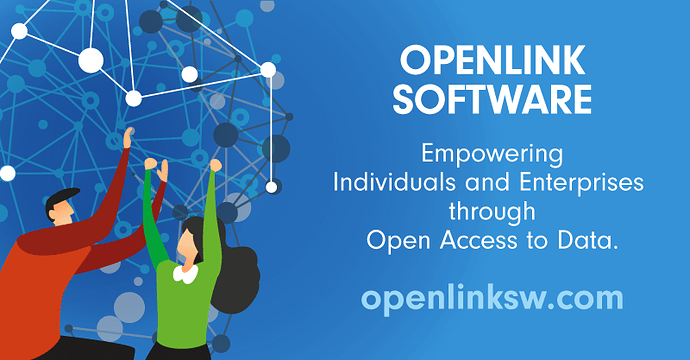Happy November All!!
Hope you have finding our weekly summaries useful!
Here is last weeks catch-up. Feel free to reach out to us, if you have a topic you would like us to cover in more detail! 
For week ending Friday, 2019-11-01
-
Demo: With a BioMedical Knowledge Graph at your disposal, you can research questions such as “What genes are associated with Asthma?” using SPARQL. It’s easy to read, too! “From the Knowledge Graph select every Gene associated with Asthma.”
-
The LOD Cloud is the largest Knowledge Graph on the planet, by far! Datao Search is a cool tool for understanding its magnitude
-
Discussion re: GraphSQL vs SPARQL
-
More RAM offers immense benefits to a DBMS like Virtuoso. For instance, building up a larger memory pool for working set cache is the only reason why we have a shared-nothing Cluster Edition.
-
We still have a Google Spreadsheet in place for crowd-sourcing a list of active SPARQL Query Service endpoints associated with nodes in the massive LOD Cloud Knowledge Graph. We will soon be transforming this into RDF for Linked Data publication.
-
Demo on how to add Linked Data, using the Virtuoso instance behind our OpenLink URIBurner service.
-
SWC Conference data slurped into OpenLink URIBurner instance. Follow-your-nose drill-down through the published Linked Data
-
Our latest iODBC release includes an ODBC Driver Manager (runtime component) that works with drivers (connectors) built using unixODBC. Thus, if PyODBC is updated to support the latest iODBC it will end up with a broadly compatible binding to ODBC data sources!
-
How does a Graph Database use a Knowledge Graph to handle Entity Resolution via PII?
-
Demo: Querying the Virtuoso instance behind our URIBurner service, with Reasoning & Inference applied to InverseFunctional Relationship Type (#PII) Semantics disabled
-
You don’t have to write any code en route to Virtuoso figuring out when to merge data from disparate sources. This is achieved by understanding that subjects are associated with personally identifiable info via an owl:InverseFunctionalProperty type.
-
You can query a GoogleSpreadsheet using SQL because a Spreadsheet is a kind of DBMS. Includes demonstration!
-
“Extending and formalizing the framework for information systems architecture” by J. F. Sowa and J. A. Zachman is a wonderful piece of reading – related to many of today’s challenges.
-
Juan Sequeda shred manuscript “A Brief History of Knowledge Graph’s Main Ideas: A tutorial”
-
Data is the new electricity. The fight for its control knows no boundaries – which is why everyone needs to take it seriously!
-
Comparing a conventional Google Search vs a Custom Search scoped to schema:JobPosting instances - see results
-
Using OpenLink URIBurner to Sponge slideshare presentation, “A MIDI-Based Benchmark for RDF Lists”
-
When you arrive at a Knowledge Graph deployed via Virtuoso, where a SPARQL endpoint is exposed, you can obtain a sampling of Entities and Entity Types descriptions across several Named Graphs as per this Claims Graph Example
-
OpenLink Data Sniffer Demo - exposing metadata inclusion in book archiving project
-
SPORTAL - Find public SPARQL endpoints on the Web
-
What works for Farm Data applies to all Data. (F)indable, (A)ccessible, (I)nteroperable, and (R)eusable Data is what happens when a Hyperlink (specifically, HTTP URI) lies at the core of your Structured Data tapestry.
-
“Property Graphs: Training Wheels on the way to Knowledge Graphs” is a title of an insightful post by Semantic Arts (champion of the Data Centric manifesto).
-
Free Trial Download of Virtuoso, our High-Performance, Scalable, and Secure Enterprise Knowledge Graph and Data Virtualization Platform
-
Free Trial Download of our Secure and High-Performance ODBC & JDBC Data Access Drivers (Connectors)
Virtuoso Use cases
Related
![]()
